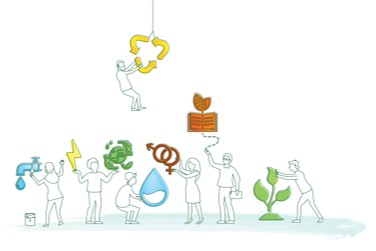Enterprise Profile
The main goal of this type of enterprise is the creation of meaningful impact for the most disadvantaged groups within the society. It is close to its end beneficiaries, and aims at serving as many of them as possible. It focuses on increasing its share of market rather than its share of wallet through a scaled operation.
Business Model Features
The enterprises in this typology typically have a diversified offering, including both products and services. They aim to serve hard-to-reach rural areas, regardless of whether the client is an end-user (B2C), business (B2B), or governmental agency (B2G). Operating in rural areas makes it particularly challenging to reach customers. Thus, the ability to innovate and adapt to changing circumstances as well as strategic partnerships for demand creation are very desirable.
Context and Environment
Since enterprises in this typology focus on selling in predominantly rural areas, delivering the last mile can be very difficult and costly. They target customers at the middle to low-income spectrum, as well as marginalized and BoP communities, and mostly operate in developing countries. Nevertheless, the countries of operation need to be conflict-free or politically stable to facilitate the work of the enterprise.
Impact Potential
This type of enterprise operates to reach communities in hard-to-reach rural areas via B2C, B2B, and/or B2G channels. The potential to create impact where it is most needed is significant. The enterprise is able to provide new and/or improved access to water to the BoP, as well as job opportunities for women, youth, and other disadvantaged groups.
Demonstrating strong impact potential in especially relevant for receiving grant and results-based financing. This is particularly important for this type of enterprises, since in most cases, they are unable to reach the level of commercial viability without grant financing or capitalizing on their impact.
Potentially relevant SDG Targets
Water-related impact
SDG 6.1 By 2030, achieve universal and equitable access to safe and affordable drinking water for all.
SDG 6.2 By 2030, achieve access to adequate and equitable sanitation and hygiene for all and end open defecation, paying special attention to the needs of women and girls and those in vulnerable situations.
SDG 6.b Support and strengthen the participation of local communities in improving water and sanitation management.
Similarly, entrepreneurs could focus on areas in waste management or agriculture where high impact can be achieved by overcoming barriers rural end-customers face.
Social impact
SDG 5.5 Ensure women’s full and effective participation and equal opportunities for leadership at all levels of decision-making in political, economic and public life
SDG 8.5 By 2030, achieve full and productive employment and decent work for all women and men, including for young people and persons with disabilities, and equal pay for work of equal value.
SDG 8.6 By 2020, substantially reduce the proportion of youth not in employment, education or training
SDG 8.8 Protect labour rights and promote safe and secure working environments for all workers, including migrant workers, in particular women migrants, and those in precarious employment
Team and Experience
The enterprise has been operational for an extended period of time and worked at least 4 years developing its business model to the context. Due to the challenging environment the enterprises operate in, it is important that it has an experienced team (4+ years professional experience) in all areas including technology, production, marketing/sales, and finance. The company benefits from strong technical and production knowledge within the team and/or uses existing technology and solutions, which indicates that R&D is not always an essential requirement.
Financial Profile
The enterprise makes use of accessible water solutions and technology and focuses on providing these solutions as a service, indicating that the up-front investment is manageable. This allows the company to reach the break-even point relatively early in the process.
However, operating in rural areas is more costly than in urban areas. This can be mainly attributed to the lower density in population and larger distances that have to be covered, leading to lower revenue streams.
The overall financial prospects are less attractive to commercial investors, and the enterprise needs compensate this with higher impact for impact-driven investors.
What are your Financing Options?
Grant and Results-based Finance (Impact bond, SIINC, performance-based loan, performance-based contract)
Given the enterprise’s focus on impact creation and serving the people at the BoP and rural areas, it is likely to attract grant-based funding. Showing that it is capable to create new and/or enhanced access to water, sanitation, and hygiene by demonstrating its past and future impact performance will further increase the chances to receive results-based financing such as performance-based contract or impact bond.
However, some results-based financing options also emphasise the importance of financial viability, which might be more difficult to show for certain businesses in this typology (e.g., SIINC or performance-based loan).
Equity or alike (common stock, preferred equity, convertible note)
The company’s generally low financial performance poses a considerable obstacle to access equity-based funding. Many investors are less likely to invest if they cannot expect a financial return in the future.
However, some investors can be convinced by: a) demonstrating financial viability by having a recurring revenue stream and b) compensating with a strong track record in water-related impact. The fact that the enterprises have already been operational for several years, are backed by an experienced team, and have the potential to create significant water impact will appeal to impact-oriented investors.
Debt or alike (debt, subordinated loan, revenue-based loan)
For this type of enterprise, it is difficult to receive debt-based funding due to its lack of financial viability. In order to access debt financing, the enterprise needs to demonstrate a recurring revenue stream and reasonable profitability. Given the volatile operational environment due to weather, seasonality, rural context, a revenue-based loan can be particularly interesting.


